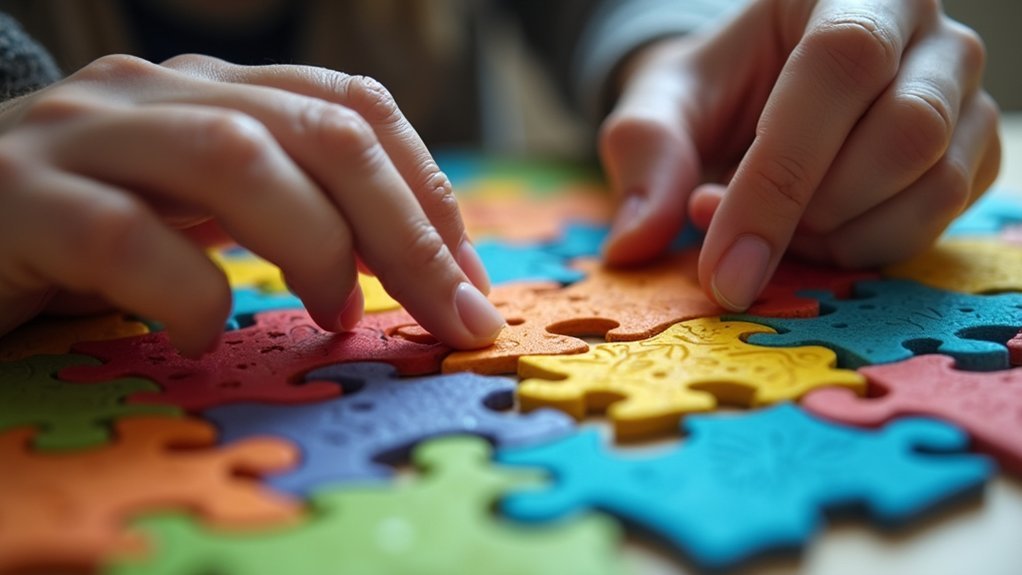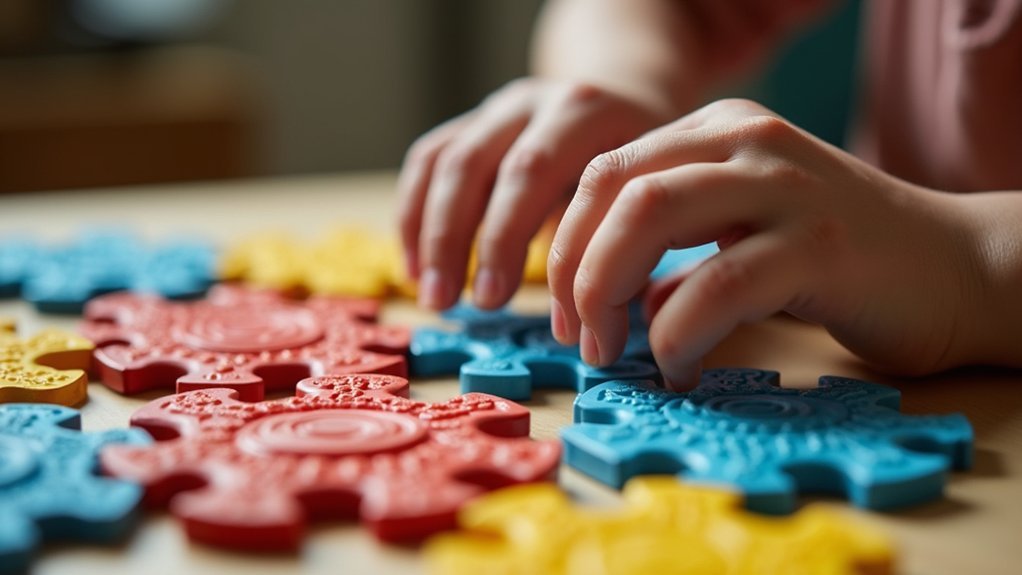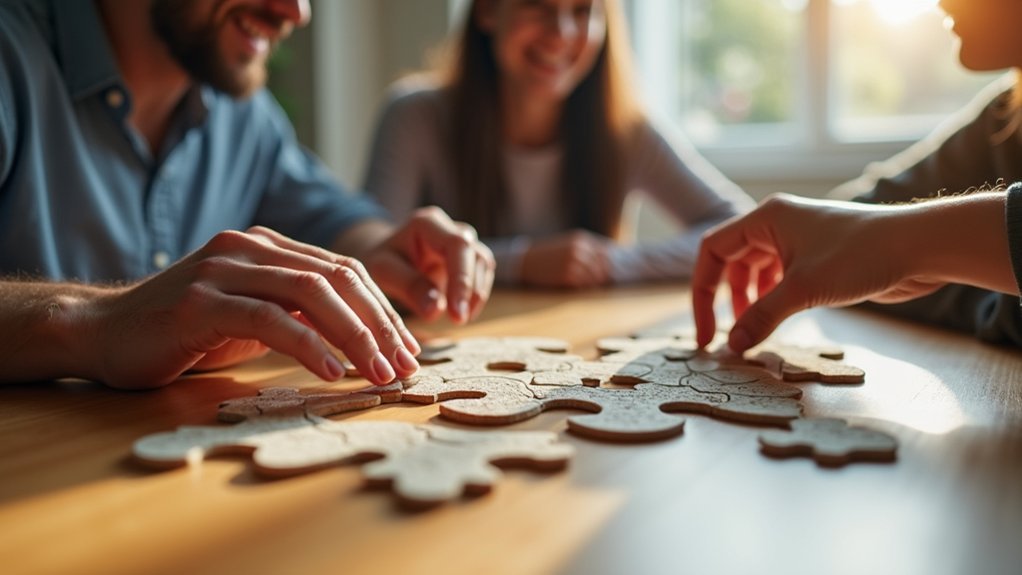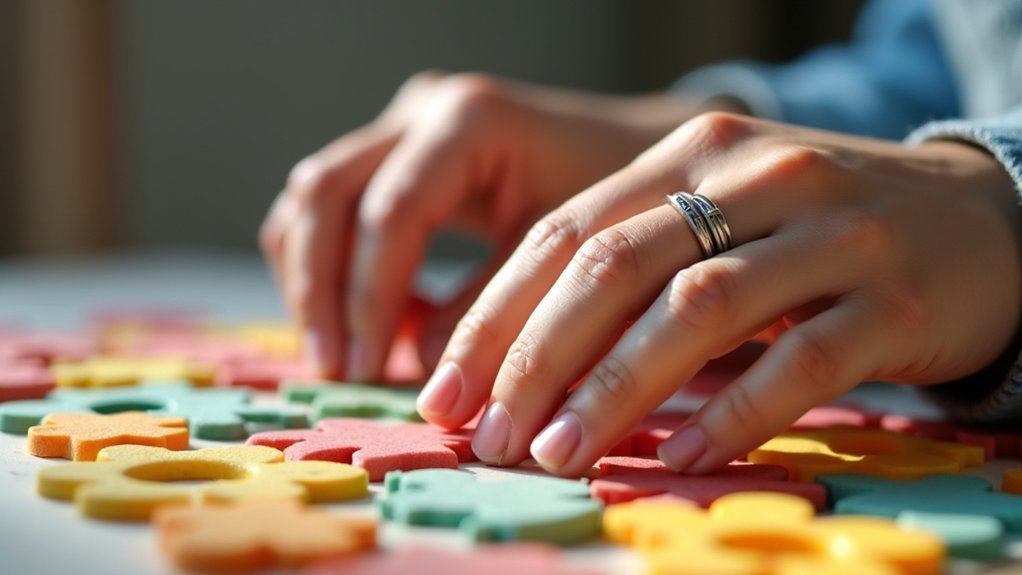Tactile puzzles enhance blind individuals’ cognitive abilities through dedicated neural pathways. You’ll find 3D maze puzzles improve spatial reasoning, while texture-based maps develop mental navigation skills. Braille-based challenges activate language processing centers, and memory puzzles strengthen problem-solving. Tactile sequential pattern games sharpen working memory and spatial cognition without visual input. These tools support education and build community connections, offering more than just entertainment—they’re gateways to expanded thinking capabilities.
The Science Behind Tactile Cognition and Brain Development

While the brain processes visual information for most people, tactile cognition operates through entirely different neural pathways that become remarkably enhanced in blind individuals.
Your somatosensory cortex, particularly area BA 3b, sorts and processes touch signals with incredible precision.
The somatosensory cortex acts as your body’s exquisite touch translator, with area BA 3b decoding tactile information into meaningful neural language.
When you engage with tactile puzzles, your brain forms new connections between sensory processing regions. This neuroplasticity enables your brain to reorganize itself, adapting to rely more heavily on touch for spatial awareness and problem-solving. Research shows that digitalized haptic information could significantly enhance these adaptive processes in technological applications.
The sustained tactile stimulation alters connectivity between interoceptive and attentional processing areas, enhancing your working memory and convergent thinking abilities.
This neural adaptation explains why tactile puzzles aren’t just entertaining—they’re actively strengthening your brain’s ability to process complex spatial information without visual input.
Types of Tactile Puzzles That Enhance Spatial Reasoning
You’ll find 3D maze puzzles offering complex pathways that require careful tactile navigation, challenging your spatial memory and orientation skills as you work through multi-level designs.
Texture-based map challenges present geographical concepts through varied surfaces that represent different terrains, landmarks, and boundaries, allowing you to mentally construct spatial relationships.
Memory Puzzles: Shapes provides a tactile braille matching game with pieces that feature raised print shapes and connecting grooves, enhancing problem-solving abilities while developing braille literacy.
These specialized puzzles develop your ability to create mental maps and understand spatial layouts without visual input, skills that transfer to real-world navigation.
3D Maze Explorations
Because they challenge users to maneuver through complex pathways without visual cues, 3D maze puzzles represent one of the most effective tactile experiences for enhancing spatial reasoning in blind individuals.
These puzzles employ vibrating tactile feedback and audio cues that help you develop robust mental maps while maneuvering through complex spatial environments.
When exploring tactile 3D mazes, you’ll benefit from:
- Multisensory integration – combining haptic and auditory signals to build extensive spatial representations without visual input
- Systematic exploration strategies – learning recursive backtracking and other maze-solving techniques that strengthen your spatial memory
- Perspective shifting – practicing mental rotation skills as you maneuver through multiple dimensions and overcome increasingly complex spatial constraints
These specialized maze designs simulate real-world maneuvering challenges while providing controlled sensory stimulation in a safe environment for cognitive growth. Similar to tilting mazes, these tactile puzzles often require navigation in three dimensions with moving surfaces that create dynamic challenges for the user.
Texture-Based Map Challenges
Texture-based map puzzles transform spatial learning for blind individuals through innovative tactile designs that engage multiple senses.
StreetScape exemplifies this approach with its modular 3D-printed components connected by magnets, allowing you to create and modify different map configurations through touch alone.
When exploring these puzzles, you’ll notice intuitive tactile cues that distinguish streets, buildings, and landmarks. The varied textures and raised patterns provide clear differentiation between features, making spatial relationships immediately apparent through your fingertips.
These map challenges aren’t just educational tools—they’re social bridges.
Many designs like StreetScape encourage collaboration between blind and sighted users, fostering inclusive play while developing critical navigation skills. Each component is constructed with durable materials like PLA or PETG to withstand repeated handling during interactive learning sessions.
Braille-Based Puzzles and Language Processing Benefits

Braille-based puzzles offer profound language processing benefits that extend far beyond simple tactile literacy.
When you engage with these puzzles, you’re activating both motor and sensory cortices, enhancing your phonological awareness and literacy skills.
Your brain demonstrates remarkable adaptability during Braille reading, with the visual word form area (VWFA) activating despite tactile rather than visual input.
This cross-modal plasticity illustrates how your brain repurposes visual areas for tactile tasks. The systematic mastery of tactile skill hierarchy is crucial for developing proficiency with these puzzles, requiring progression from concrete to abstract concepts.
- Braille puzzles improve syntax comprehension through enhanced tactile perception
- They connect finger sensitivity with linguistic concepts, building semantic understanding
- Regular engagement strengthens the somatosensory network, motor network, and cerebellar network
These cognitive benefits are particularly pronounced in early blind individuals, whose neural systems show greater adaptation compared to those who lose sight later in life.
Textured 3D Puzzles for Developing Mental Mapping Skills
Textured 3D puzzles can notably enhance your spatial awareness through hands-on exploration of topographical elements that create thorough mental maps.
You’ll develop sequential pattern recognition skills as you assemble puzzle pieces in logical order, strengthening your ability to mentally navigate physical environments without visual cues.
These puzzles are expertly designed to adapt cognitive load based on your experience level, allowing for progressive skill development as you master increasingly complex spatial relationships.
Some innovative designs incorporate vibration feedback mechanisms that provide tactile reinforcement when pieces are correctly placed, offering an additional sensory dimension to the learning experience.
Spatial Awareness Enhancement
While traversing our visual world, blind individuals rely heavily on tactile feedback to develop mental mapping skills. Textured 3D puzzles activate the same visuo-spatial pathways in blind individuals as in sighted people, creating comparable mental representations through touch rather than sight.
You’ll find these tactile puzzles enhance spatial awareness through:
- Physical manipulation – Solving 3D puzzles requires hands-on interaction that strengthens mental imagery development and spatial planning.
- Brain plasticity utilization – Regular engagement with tactile spatial tasks helps the brain adapt and code spatial patterns effectively. Incorporating Feel n Peel Sheets with varied textures can significantly enhance these puzzles for better tactile differentiation.
- Collaborative learning opportunities – Puzzles like StreetScape foster interdependence between sighted and blind individuals, promoting inclusive spatial reasoning skills.
The supramodal nature of spatial processing means you don’t need vision to develop sophisticated mental maps—you just need the right tactile tools.
Sequential Pattern Recognition
Sequential pattern recognition forms the cornerstone of spatial cognition for blind individuals traversing a primarily visual world.
When you explore tactile puzzles with varying textures and 3D elements, you’re building mental maps through touch that sighted people create visually.
Textured puzzles featuring rough-smooth and big-little contrasts help you develop essential tactile discrimination skills. These exercises require systematic exploration—one aspect at a time—to construct complete mental images.
You’ll need more repetition than sighted peers to master these skills, progressing from concrete to abstract concepts.
As you work through tactile braille puzzles and explore tactile trails, you’re strengthening the same neural pathways needed for braille literacy.
This sequential learning follows a hierarchy that gradually builds confidence while enhancing problem-solving abilities essential for academic subjects like mathematics.
Products like Slide, Twist, ‘N Solve offer engaging ways to explore part-whole relationships while developing important spatial reasoning skills.
Cognitive Load Adaptation
When engaging with tactile puzzles, you’ll encounter varying levels of cognitive load based on puzzle complexity and your individual adaptation capabilities.
Textured 3D puzzles create higher cognitive demands while simultaneously developing your spatial awareness and mental mapping skills vital for navigation.
As you explore these puzzles, you’re building essential cognitive skills through:
- Working memory enhancement – simultaneously comparing and storing different tactile inputs strengthens your memory capacity
- Spatial reasoning development – manipulating puzzle pieces improves your ability to understand object relationships without visual input
- Attentional focus training – directing cognitive resources to specific tactile cues sharpens your concentration abilities
Your adaptation to increased cognitive load stabilizes over time, indicating improved cognitive flexibility and spatial understanding as you master increasingly complex puzzles.
Gradually introducing puzzle pieces one at a time can reduce overwhelming tactile information while promoting visual familiarity for those with remaining sight.
Sequential Problem-Solving Through Touch-Based Games
As blind individuals engage with tactile puzzles, they’re developing sophisticated sequential problem-solving skills that extend far beyond the game itself. When you work with games like the Triangle Puzzle, you’re learning to arrange pieces in specific orders, building spatial reasoning and geometric understanding through touch alone. The TacPic system has revolutionized the creation of these tactile materials, reducing production time from weeks to a few hours.
| Game Type | Sequential Skill | Real-World Application |
|---|---|---|
| Triangle Puzzle | Geometric reasoning | Navigation planning |
| StreetScape | Spatial sequencing | Environmental mapping |
| Modular Puzzles | Step-by-step assembly | Daily task organization |
| Texture Games | Pattern recognition | Coding and mathematics |
These puzzles offer you a structured way to develop cognitive strategies through tactile feedback. By identifying, connecting, and arranging pieces in logical sequences, you’re strengthening memory, critical thinking, and problem-solving abilities essential for independence in everyday life.
Memory Enhancement Exercises Using Tactile Materials

Memory enhancement through tactile materials offers blind individuals powerful ways to sharpen their cognitive abilities beyond sequential problem-solving.
Research shows that your brain can repurpose visual areas for tactile memory, allowing you to excel in spatial tasks and develop stronger working memory.
To maximize tactile memory enhancement, consider these exercises:
- Pattern reproduction training – Practice feeling and recreating sequential vibration patterns, which strengthens your ability to integrate tactile information over time.
- Spatial memory challenges – Use tactile maps or boards where you must remember the location of objects, engaging supramodal brain representations.
- Cross-modal memory games – Train with exercises that combine tactile exploration with audio cues, leveraging the brain’s plasticity to improve overall cognitive fitness.
These approaches provide immediate feedback, essential for optimizing memory retention and cognitive development. Studies demonstrate that practicing with tools like Corsi boards can result in significant improvements in visuospatial working memory, even when adapted for tactile use.
Educational Settings: Implementing Tactile Puzzles for Inclusive Learning
Implementing tactile puzzles in educational settings creates transformative learning environments where blind students can fully participate alongside their sighted peers. You’ll find these tools enhance retention and boost engagement by activating multiple sensory pathways.
| Implementation Strategy | Benefit | Challenge |
|---|---|---|
| Integrate with curriculum | Supports required learning outcomes | Requires customization |
| Pair with assistive tech | Enhances accessibility | Technical infrastructure needed |
| Use in collaborative work | Promotes inclusive participation | Teacher training required |
| Apply across subjects | Strengthens interdisciplinary skills | Resource availability limited |
| Incorporate tutor feedback | Improves implementation methods | Needs consistent assessment |
Teachers report that tactile puzzles like embossed geometry sets and accessible Sudoku games greatly improve visually impaired students’ understanding of complex concepts while building their confidence in mathematics and science. Games such as the Blindfold Sudoku provide an excellent resource with five puzzles of varying difficulty that help develop logical thinking skills through audio play.
Building Social Connections Through Accessible Puzzle Play

When blind individuals engage in tactile puzzle play with others, they’re not just solving problems—they’re building meaningful social bridges. Accessible puzzles create environments where visually impaired people can develop essential social skills while enjoying shared experiences with sighted peers, family members, and other blind individuals. Games like Tactile Shift Puzzle Game and Tactile Puzzle Rubiks Cube provide engaging challenges that encourage cognitive development through tactile exploration.
Organized puzzle activities offer multiple social benefits:
- Community building – Tactile puzzle events foster inclusivity and create supportive networks where participants develop lasting connections.
- Mutual learning opportunities – Players share strategies and insights, learning from each other’s unique approaches to problem-solving.
- Confidence development – Regular social interaction through puzzles helps reduce isolation while building social confidence in various settings.
You’ll find that accessible puzzles transform from simple games into powerful tools for connection, emotional support, and community integration.
Frequently Asked Questions
At What Age Should Blind Children Start Using Tactile Puzzles?
You should introduce your blind child to simple tactile puzzles around 2 years old, depending on their motor skills. Start with basic shapes and gradually increase complexity as they develop their tactile exploration abilities.
How Do Tactile Puzzles Compare to Audio-Based Learning Tools?
Tactile puzzles engage your spatial reasoning directly while audio tools focus on auditory processing. You’ll find tactile learning provides hands-on spatial awareness, whereas audio tools excel in sequential information. Consider combining both for thorough learning.
Can Tactile Puzzles Help With Math and Science Concept Understanding?
Yes, tactile puzzles greatly enhance your math and science learning. You’ll grasp geometry through triangle puzzles, understand spatial concepts hands-on, and explore scientific principles through immediate tactile feedback, improving your retention and engagement.
Do Tactile Puzzles Benefit Adults With Late-Onset Blindness Differently?
Yes, you’ll find tactile puzzles especially helpful if you’ve lost sight later in life. They’ll aid your cognitive adjustment, help retain spatial skills, and provide psychological support during your change to steering without vision.
What Maintenance and Cleaning Protocols Extend Tactile Puzzle Lifespan?
You’ll extend your tactile puzzles’ lifespan by cleaning with soft brushes, using mild soap for deeper cleaning, promptly repairing loose parts, storing in dry environments, and handling gently with clean hands to preserve textural details.
In Summary
You’ve discovered how tactile puzzles open worlds of cognitive development for blind individuals. Whether you’re working with Braille-based logic games, textured 3D puzzles, or sequential touch materials, you’re supporting critical thinking skills that transcend vision. By incorporating these accessible tools into educational and social settings, you’re not just solving puzzles—you’re building inclusive communities where everyone’s thinking abilities are recognized, valued, and enhanced.





Leave a Reply